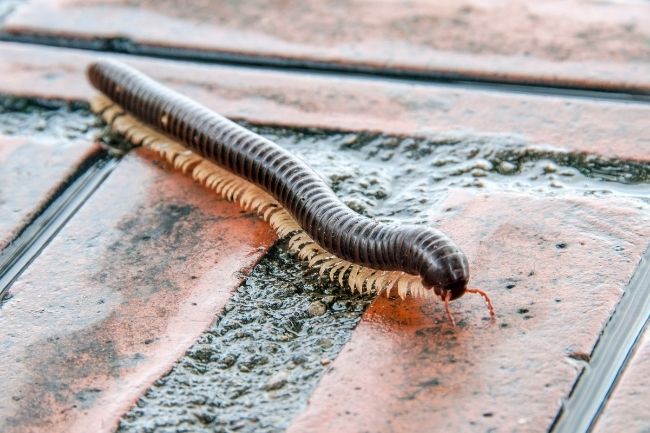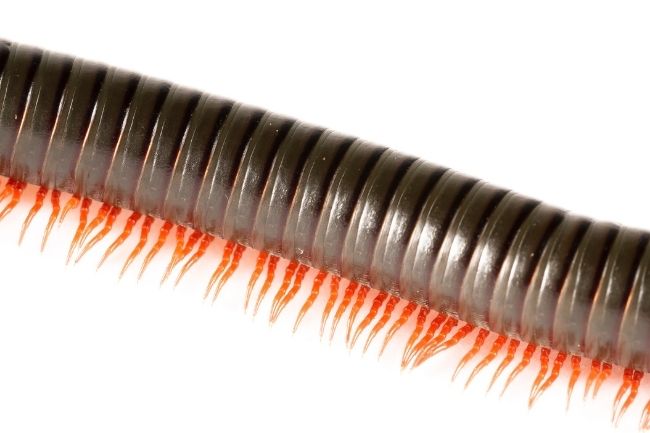The number of legs millipedes have varies between species. The majority have around 400 legs, while some rarer species have between 700 and 1,300 legs. Millipedes have two legs per body segment, while the similar centipedes have only one.
Contents
What are millipedes?

Millipedes are some of the most ancient terrestrial arthropods, having roamed the earth since the Silurian era. Along with centipedes, they are part of the Myriapoda group and are well known for their long bodies and many legs.
Across the world, there are over 10,000 species, which range from tiny common centipedes to fantastical giant centipedes.
Their diet is made up largely of plant matter, with most centipedes being detritivores, eating dead plant matter and fungi. A small number of species are carnivorous, though this often involves eating already dead animals.
Millipedes are mostly solitary creatures and spend much of their time burrowing through the earth, crawling under rocks or travelling along the surface of the soil.
As arthropods, they have a hard exoskeleton, made of chitin, the same material as our fingernails. They are able to move through the use of a series of interlocking plates.
Millipedes have three main body segments, the head, thorax and abdomen. However, each of these parts is further divided into additional segments, each of which has two sets of legs. The first few segments immediately behind the head only have one set of legs.
Also read: Millipedes and Centipedes – The Difference Explained
Do millipedes have 1000 legs?
Millipedes got their name from the belief that these arthropods have 1,000 legs, however, until recently, there weren’t any species identified to have more than 750 legs. Today, one species has been discovered with more than 1,300 legs.
Eumillipes Persephone was discovered 60m (196ft) underground in old mines in Australia. This long pale millipede had some individuals with over 1,300 legs, while other individuals had between 700-800 legs.
Aside from these few anomalies, the majority of millipedes have around 400 legs, those there is huge variability between different species.
| Millipede Species | Number of Legs |
|---|---|
| Common Millipede | 30-400 |
| Banded Millipede | 30-90 |
| Giant African Millipede | 256 |
| Fire Millipede | 62-400 |
| Ivory Millipede | 36-400 |
How do millipedes use their legs?

Millipedes largely use their legs for walking, which may seem simpler than it really is. Because of how many legs they have, and how closely spaced they are, millipedes are forced to walk significantly slower than a centipede.
In order to travel along the ground millipedes move their legs in a wave-like motion, their bodies also undulating to help with the movement. They also have slightly longer legs at the back of their bodies, to help prevent their legs from tripping each other up.
| Leg Pair | Function |
|---|---|
| 1st Pair | Sensory organs, detecting touch and vibration |
| 2nd Pair | Support and stability during movement |
| 3rd Pair | Assisting in coordination and balance |
| 4th Pair | Aid in gripping and maneuvering over surfaces |
| 5th Pair | Propelling the millipede forward |
As well as using their legs for walking, millipedes’ legs are an important part of their mating process. They have specialist legs called gonopods, which are adapted to be used as part of the mating process. They use these legs to transfer sperm packets from their own reproductive organs to those of the female.
Aside from these main tasks, a millipede’s many legs also assist it in tunnelling. Millipedes tunnel to find food, but they also create burrows to lay their eggs in, in order to keep the young safe as they develop.
Also read: Wondering “If Millipede is an Insect”? – Explained
Why is it so important for millipedes to have so many legs?
Millipedes are a very ancient group of animals, that have kept their shape very much the same since they first appear in the fossil records. So while their large number of legs might seem unusual to us, it clearly works well for them.
| Leg Pair | Adaptation |
|---|---|
| 1st Pair | Sensitive setae for detecting environmental cues and potential prey |
| 2nd Pair | Sturdy structure for weight-bearing and locomotion |
| 3rd Pair | Coordinated movements for smooth and efficient locomotion |
| 4th Pair | Specialized structures for gripping surfaces and navigating obstacles |
| 5th Pair | Modified leg segments for effective propulsion |
The reason for their many legs is unclear, but it’s likely it assists them in finding food, through allowing them to burrow better or move through tight spaces.
What are these “legs” called?

While we may not think of the more simplistic legs of millipedes as being the same as our legs, this is indeed what they are. They perform exactly the same function as our limbs, and therefore we give them the same name.
Baby legs
Interestingly, millipedes aren’t born with their many legs in place. Baby millipedes are born without any legs, and only gain their first few pairs once they have their first two moults.
After this initial gain, more legs are added with each moult as they continue to grow.
Millipede species
Giant African millipede (Archispirostreptus gigas)
The giant African millipede is the largest millipede in the world, reaching up to 33.5 cm (13.18 in) long. With its dark body and brown legs, it’s an attractive species, often kept as a pet. Though it may appear a little intimidating at first, due to its size, it is completely harmless, eating largely rotting vegetation.
In total, the giant African millipede generally has between 300 and 400 legs. It’s also been found that this mammoth millipede has a symbiotic relationship with a tiny species of mites, which live in its exoskeleton and help clean away any dirt and debris from its skin.
American giant millipede (Narceus americanus)
While not the largest millipede in the world, the American giant millipede is still pretty impressive, measuring around 10 cm. Its dark body is broken up by orange stripes across its segments, and its legs are an eye-catching hue of red.
Until recently, it was also the species with the largest number of legs, having 375 pairs, so 750 in total.
However, the recent discovery of a species with over 1,000 legs has left the American giant millipede a little lacking.
White legged Snake Millipede (Tachypodoiulus niger)
Growing up to around 6 cm (2.36 in), the white legged snake millipede is a common species found in gardens and woodlands. Its name comes from its obvious white legs, which stand out in stark contrast to its shiny black body. Much smaller than some of the giant millipedes, this species unusually has around 100 legs.
Found under rocks and within rotting wood, the white legged snake millipede is a detritivore, feeding largely on dead plant matter.
Crested Millipede (Abacion magnum)
Crested millipedes are so named because of the various ridges and furrows they have on their exoskeletons. In total, there are around 130 species of crested millipede. Abacion magnum is a long, thin millipede, that is sometimes kept as a pet.
Interesting, this species has been observed eating dead insects, unlike many other millipede species, that stick to a more vegan diet.
Colourful Cherry Millipede (Apheloria polychroma)
The colourful cherry millipede is so named because of the wonderful range of colours it displays. As well as a largely black body, it has spots that can range from white to yellow and orange, and similarly colourful legs.
These bright colours actually hide a nasty secret, however, as the millipede is covered in a poisonous coating of cyanide. This deadly lacquer helps to keep it off the menu. Another odd quirk is that the toxic substances that this millipede exudes are actually said to smell like cherries.
A fairly short and stout millipede, the colourful cherry millipede only comes in with around 25 legs.
Flat-backed millipede (Polydesmus angustus)
The flat-backed millipedes are fairly distinctive in their look, with a very obviously flattened form. Because of this form, however, they are some of the few species that might be easily mistaken for centipedes. However, the rule of two legs per segment for millipedes and one leg per segment for centipedes still holds true.
Polydesmus angustus is a small, reddish, brown species of flat-backed millipede, usually around 2.5 cm (0.98 in) long. In general, this smaller species has only around 40 legs.
Large snake millipede (Cylindroiulus caeruleocinctus)
The large snake millipede could easily be confused for the white legged snake centipede, appearing in similar habitats, and having similar colourings. However, this species is somewhat smaller, reaching only around 3 cm (1.18 in) in length.
Yellow-spotted millipede (Harpaphe haydeniana)
The yellow-spotted millipede is another member of the flat-backed millipedes, but is rather eye-catching with its black body edged with bright yellow spots. Like the colourful cherry millipede, it excretes cyanide to prevent itself from becoming dinner.
Found in damp forests, this millipede generally has around 31 pairs of legs once fully grown.
The Florida Ivory millipede (Chicobolus spinigerus)
The Florida ivory millipede gets its name from its wonderful pale stripes, and the location it is commonly found in. A large millipede species, it can grow up to 90 cm (35.43 in) in length.
Its large size, and its attractive patterning, make it a popular household pet.
Giants of the past
Like many of our invertebrates, the Earth of the past, when oxygen levels were significantly higher, was truly their domain, a place where they ruled as giants. Today, the largest millipede fossil ever discovered is of the Arthropleura species. The fossil shows a creature that would have been over 2.5m (98.42 in) in length.
Amazingly, however, this monster millipede still didn’t live up to its name, with researchers thinking it may have had as few as 32 legs. So even though our modern millipedes might be much smaller, they certainly have gained a limb or two along the way.
A beast with many legs
Millipedes it seems come with all number of legs attached, with some species having significantly more than others. Interestingly, too, the number of legs doesn’t always seem to correlate with the size of the millipede itself.
When it comes to the millipede, nature seems to have been rolling the dice to decide how many limbs might be most appropriate. Still, this highly successful group doesn’t seem to have minded, getting on with their business, no matter how many feet they’ve been given.
Perhaps if millipedes had become dangerous predators the number of legs they possessed might have been more of a concern, but as the vast majority of these invertebrates spend their time under rocks or in compost heaps, munching away at dead plant matter, their legs really don’t seem to get in their way.
Lucky for them, or it might have been a very different story for the millipede.

